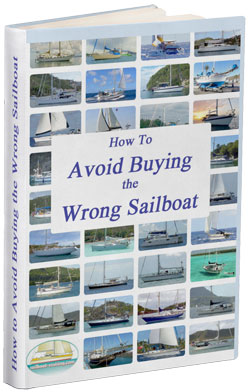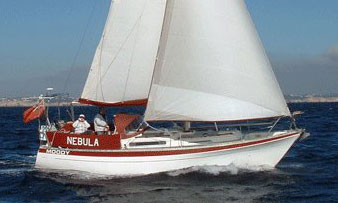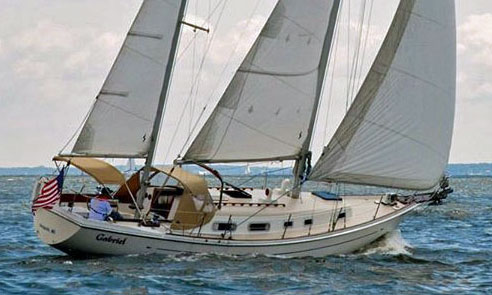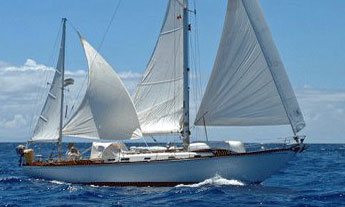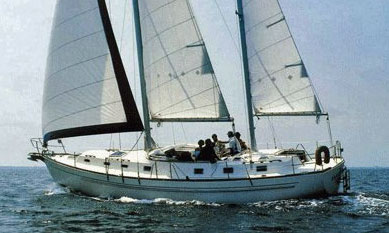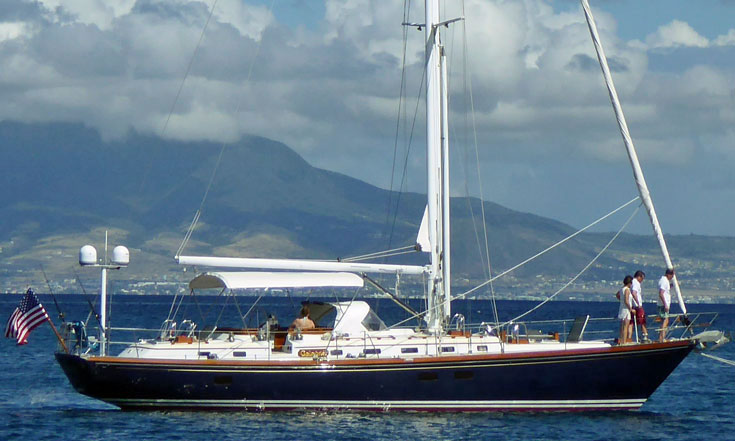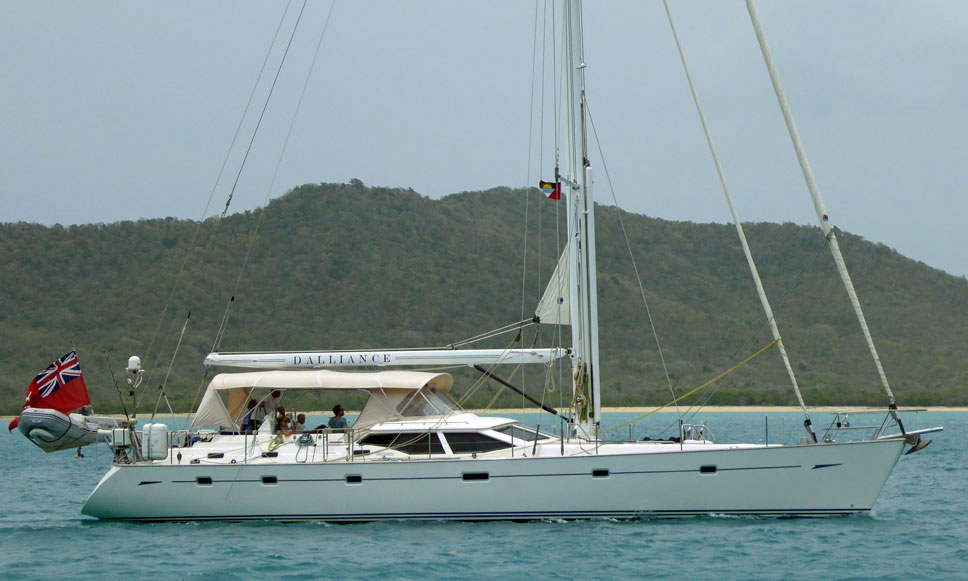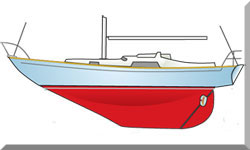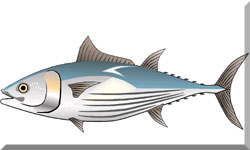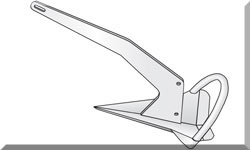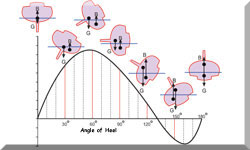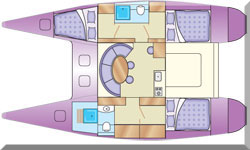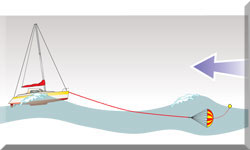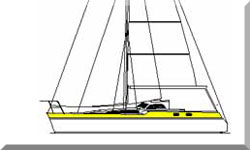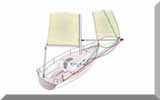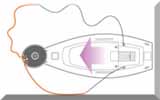- Home
- Cruising Yachts 45' to 50'
- Hinckley 48
The Hinckley 48 Sailboat
Specs & Key Performance Indicators
The Hinckley 48 sailboat was designed by William H. Tripp Jr. and manufactured by Henry Hinckley & Company in the United States throughout the years 1965 to 1974.
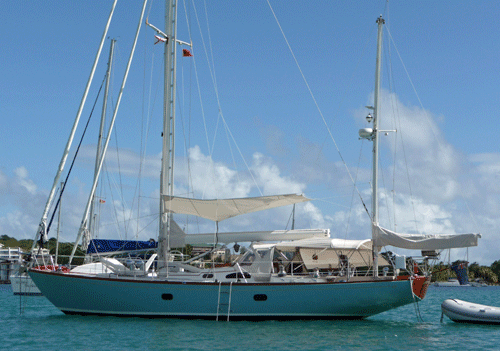 A Hinckley 48
A Hinckley 48Published Specification for the Hinckley 48
Keel & Rudder Configuration: Long keel with a bronze centreboard, operated via a worm gear, and a keel-mounted rudder controlled by a wheel. The centreboard is designed to kick up in a grounding.
- Hull Material: Fibreglass
- Length Overall*: 48'3" (14.70 m)
- Waterline Length*: 34'2" (10.42 m)
- Beam*: 13'0" (3.96 m)
- Draft*: 5'2" (1.58 m) with centreboard up, and 11'9" (3.58 m) with centreboard down.
- Rig Type: Masthead Sloop (standard) or Yawl (optionally available for some models).
- Displacement*: 36,000 lbs (16,330 kg)
- Ballast*: 10,600 lbs (4,808 kg)
- Sail Area (main plus 100% foretriangle)*: 1017 ft² (94.48 m²)
- Water Tank Capacity: 250 gals (946.35 litres)
- Fuel Tank Capacity: 100 gals (378.54 litres)
- Hull Speed: 7.83 knots (14.50 km/h)
- Designer: William H. Tripp Jr.
- Builder: Hinckley Yachts
- Year First Built: 1965
- Year Last Built: 1974
- Number Built: 8
* Used to derive the design ratios referred to later in this article - here's how they're calculated...
Options & Alternatives
Buyers of the Hinckley 48 had some choices, particularly concerning:
- Rig type: The Hinckley 48 was primarily yawl-rigged, but a few were ordered as sloops.
- Deep or shallow draft: The Hinckley 48 featured a centreboard keel, allowing for both a shallow draft (5'2" or 1.58 m with board up) for accessing shallower waters and a deep draft (11'9" or 3.58 m with board down) for enhanced offshore performance and upwind capability.
- Interior layouts: While specific detailed interior layout options are not extensively documented, Hinckley yachts are renowned for their customisability and high-quality interiors. A standard layout included a V-berth forward, a seat, and stowage under berths, along with a full 6'9" headroom in the main saloon and a galley aft.
Alternative Versions During Production
The Hinckley 48 was itself a larger iteration designed for Hinckley Bermuda 40 owners. The main "alternative version" during its production run was the choice between the yawl and sloop rig configurations.
Sail Areas & Rig Dimensions
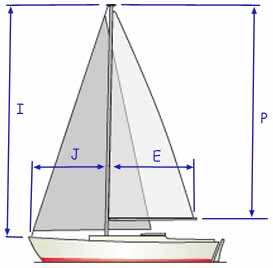 Sail Areas & Rig Dimensions
Sail Areas & Rig DimensionsSail Areas
- Mainsail Area: 503.51 ft² (46.78 m²)
- Foretriangle Area (100%): 513.24 ft² (47.68 m²)
Rig Dimensions
- I (Foretriangle height): 56'5" (17.19 m)
- J (Foretriangle base): 18'2" (5.55 m)
- P (Mainsail luff): 50'1" (15.27 m)
- E (Mainsail foot): 20'1" (6.13 m)
Published Design Ratios
The Key Performance Indicators (KPIs)
- Sail Area / Displacement (SA/D): 14.99
- Ballast / Displacement (Bal./Displ.): 29.44 %
- Displacement / Length (D/L): 402.83
- Comfort Ratio: 47.60
- Capsize Screening Formula (CSF): 1.58
Theoretical Sailing Characteristics
The design ratios offer a theoretical glimpse into how the Hinckley 48 sailboat might perform:
- Displacement / Length Ratio (402.83): This is a very high D/L ratio, indicating a heavy displacement vessel. Boats with high D/L ratios are generally characterised by a comfortable motion in a seaway, making them well-suited for offshore cruising and passagemaking. They are less sensitive to overloading compared to lighter displacement boats. However, a high D/L ratio also suggests the boat will be slower in light to moderate winds and will require more sail area to achieve decent speeds.
- Sail Area / Displacement Ratio (14.99): An SA/D ratio of 14.99 places the Hinckley 48 on the cusp of being considered "under-canvased" (under 15 generally indicates under-canvased) or just about "reasonably good performance" (values above 15). This suggests the Hinckley 48 might be slightly underpowered, particularly in lighter wind conditions. It would likely perform better in moderate to heavy air, where the ample displacement provides stability and the sail area, while not extremely generous, can still drive the substantial hull through the water. This aligns with its character as a heavy bluewater cruising boat.
- Ballast / Displacement Ratio (29.44%): A ballast ratio of 29.44% is on the lower side for what is typically considered a "stiffer" boat (often 40% or more). This suggests the Hinckley 48 might not be exceptionally "stiff" and could heel more readily than boats with higher ballast ratios. However, ballast placement significantly impacts righting moment, and the Hinckley 48's long keel with a centreboard provides good righting capability despite the lower ratio.
- Comfort Ratio (47.60): A comfort ratio of 47.60 indicates a very comfortable motion in a seaway. This ratio gives an idea of how easily the boat pitches and rolls, with higher numbers generally indicating a smoother ride. This aligns with its heavy displacement, making it suitable for extended cruising and offshore passages where comfort is paramount.
- Capsize Screening Formula (1.58): A CSF value of 1.58 is well below the generally accepted threshold of 2.0 for offshore sailing. This indicates the Hinckley 48 has an excellent theoretical resistance to capsize, making it a very safe and stable vessel for offshore and blue-water cruising.
In summary, the Hinckley 48 is theoretically a heavy, comfortable, and very stable bluewater cruising sailboat, well-suited for extended voyages and handling rough seas. It might be less agile and slower in light winds due to its substantial displacement and slightly lower SA/D, but its high comfort and capsize ratios point to a secure and pleasant experience for long-distance sailing.
But the Design Ratios are Not the Whole Story...
While design ratios offer valuable insights, they have several limitations:
- Simplification of Complex Dynamics: Ratios reduce complex three-dimensional shapes and fluid dynamics to single numbers. They don't account for the nuances of hull form, keel and rudder foil shapes, appendage placement, or the precise distribution of displacement and ballast. These subtle differences can significantly impact performance and handling.
- Ignores Sail Plan Efficiency: The SA/D ratio only considers total sail area. It doesn't differentiate between rig types (masthead vs. fractional), the efficiency of different sail shapes, or the interaction between sails, all of which impact actual performance.
- No Account for Construction Quality and Weight Distribution: Ratios assume a "standard" boat. Variations in construction materials, internal fit-out, and the placement of heavy components can alter actual displacement, trim, and stability, which are not reflected in basic ratios.
- Excludes Crew Skill: A boat's real-world performance is heavily influenced by the crew's skill in trimming sails, steering, and making tactical decisions. Ratios are static and cannot predict performance in the hands of different sailors.
- Doesn't Factor Real-World Conditions: Ratios are theoretical and do not account for dynamic conditions such as waves, gusts, current, or sea state.
- Limited for Upwind Performance: While SA/D indicates power, it doesn't directly measure how well a boat will point into the wind or its leeway. These depend more on keel and rudder design and the lateral plane.
- Ballast Ratio vs. Righting Moment: The ballast ratio is a simple percentage, but the placement of the ballast is crucial. Ballast deep in a fin keel provides more righting moment than the same weight of internal ballast.
- CSF as a Screening Tool Only: The Capsize Screening Formula is a valuable initial indicator, but it's not a definitive safety guarantee. It screens for general resistance to capsize; other factors like stability curve shape and damage stability are also vital.
- Evolution of Design Philosophies: Ratios derived from older design philosophies (e.g., long keel, heavy displacement) may not directly compare with modern designs (e.g., fin keel, light displacement) in terms of actual performance or comfort.
- Subjectivity of "Comfort": While the comfort ratio aims to quantify it, comfort is ultimately subjective and can vary from sailor to sailor.
In conclusion, design ratios are excellent starting points for comparing and understanding the general characteristics of different sailboats. They provide a quick, numerical way to categorise a boat. However, for a truly comprehensive understanding, these ratios must be considered in conjunction with detailed design drawings, stability curves, sea trial reports, owner reviews, and ideally, first-hand experience on the water.
More Specs & Key Performance Indicators for Popular Cruising Boats
Recent Articles
-
Hans Christian 43: Classic Bluewater Cruiser & Liveaboard Sailboat
Dec 10, 25 04:37 AM
Explore the Hans Christian 43: a legendary heavy-displacement, long-keel sailboat. Read our in-depth review of its specs, design ratios, and suitability for offshore cruising and living aboard. -
Planning Your Sailboat Liveaboard Lifestyle: An Ocean Sailor's Guide
Dec 06, 25 05:18 AM
Seasoned sailors share their methodical risk analysis for planning a secure Sailboat Liveaboard Lifestyle, covering financial, property, and relationship risks. -
Marine Cabin Heaters: The Expert’s Guide to Comfort & Safety at Sea
Dec 05, 25 06:52 AM
Choose the best Marine Cabin Heaters for your vessel. Expert advice on diesel, paraffin, and hot water systems for year-round cruising comfort.
